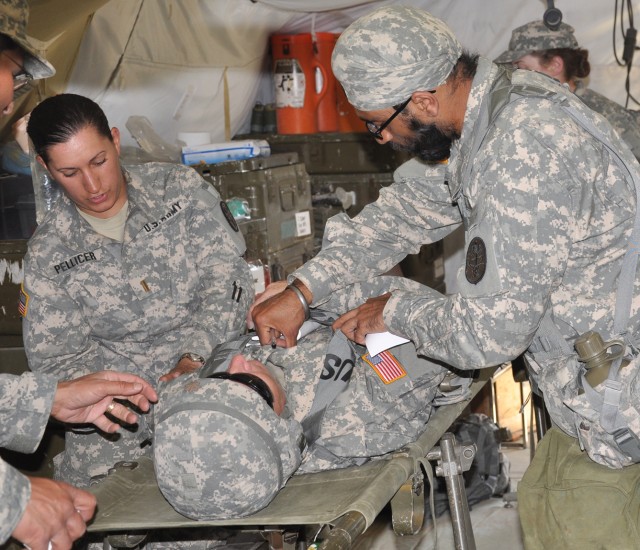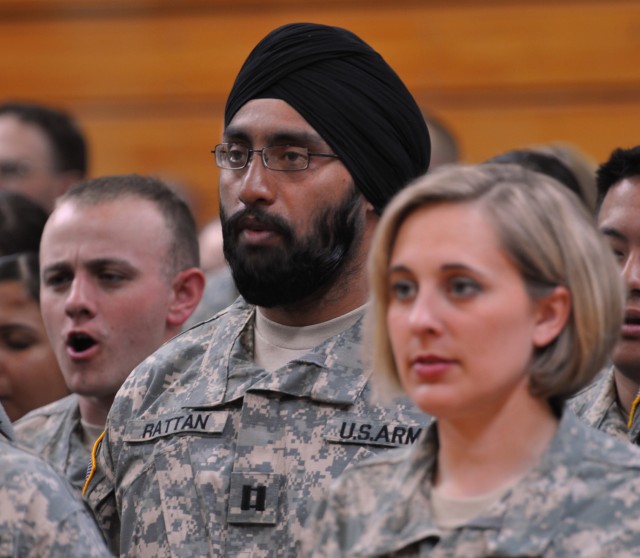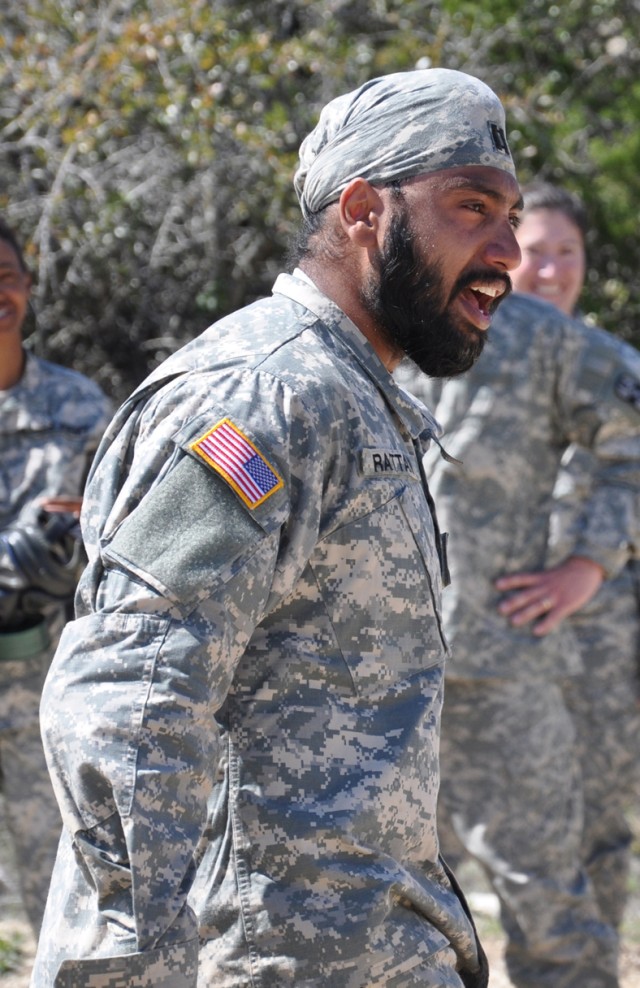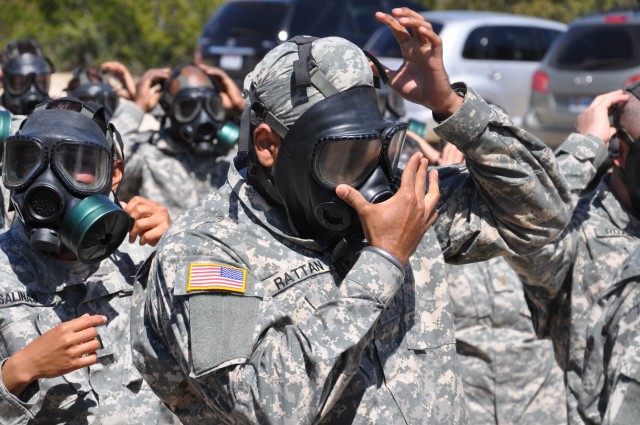FORT SAM HOUSTON, Texas (March 25, 2010) -- For the first time in 23 years, the U.S. Army is allowing a pair of Sikh Soldiers to keep their hair and beard intact and wear a turban.
More than 60 years ago, President Harry Truman desegregated the U.S. armed forces, declaring "there shall be equality of treatment and opportunity for all persons in the armed forces without regard to race, color, religion or national origin."
But during those same six decades, the Army's policy and how it was implemented changed from time to time.
From 1948 to 1984, men of the Sikh religion were permitted to serve while maintaining their articles of faith. In 1984, Gen. John A. Wickham Jr., then Chief of Staff of the Army, eliminated the exception for Sikhs and others who wore "conspicuous" items of faith.
Sikhs who were previously serving on active duty were grandfathered in by the Army. Two Sikhs in the medical field, Col. Arjinderpal Singh Sekhon, a doctor, and Col. G.B. Singh, a dentist, continued to serve until their retirements in 2009 and 2007, respectively, according to the Sikh News Network Web site (http://www.sikhnn.com).
Capt. (Dr.) Tejdeep Singh Rattan, a dentist, and Capt. (Dr.) Kamaljeet Singh Kalsi, a doctor, were assured by their recruiters at the time of enlistment several years ago that their articles of faith wouldn't pose a problem. But after completing four years of studies, both men were told to remove their turbans and cut their hair and beards for active duty.
It took action by several Sikh organizations and a letter to Defense Secretary Robert Gates, signed by 43 members of the House of Representatives and six U.S. senators, to change the Army's mind. A pair of special exceptions to Army Regulation 600-20 were allowed so Rattan and Kalsi could wear their dastaars (turbans) and keep their unshorn hair and beards as part of their uniform, and also retain their other articles of faith.
"Based on a review of these standards and the specific facts of your case, I am granting your appeal to wear a beard, uncut hair and turban in keeping with the tenets of your faith," wrote Maj. Gen. Gina Farrisee, acting deputy chief of staff for Army personnel, in a Dec. 1 letter to Rattan. "Your beard, uncut hair and turban will be neat and well maintained at all times."
The Army does allow personnel to request waivers for practices that may conflict with current Army regulations and policies and are considered on a case-by-case basis.
Considerations include the impact on the health, safety and welfare of all Soldiers; and impact on order and discipline of the force. The Army decided in these two cases that the Sikh articles of faith would not affect "unit readiness, individual readiness, unit cohesion, morale, discipline, safety and/or health," according to Farrisee's letter.
Rattan completed the nine-week Basic Officer Leadership Course at Camp Bullis, Texas, March 19, and graduated with his class at Fort Sam Houston, March 22. He'll report to Fort Drum in upstate New York April 12 for an assignment as a dentist. Kalsi, who attended Rattan's graduation begins the BOLC course in July, after completing an emergency medicine fellowship.
But the story behind Rattan's journey through the military Health Professions Scholarship Program and into the Army's corps of officers sheds light on a little-known change in Truman's promise that has virtually prevented an entire generation of Sikhs from serving in the United States armed forces.
Practicing Sikhs have served in the armed forces since World War I, and the ruling in 1984 which effectively disallowed Sikhs to join was due to alleged health and safety hazard of their turban and uncut hair.
Aided by the Sikh Coalition (http://www.sikhcoalition.org), Kalsi and Rattan appealed the Army policy because of religious convictions. They were joined by the Sikh Council on Research and Education, Sikh American Legal Defense and Education Fund and United Sikhs. Thousands of Sikhs and other sympathetic supporters signed petitions on their behalf.
To put their faith into perspective, there are 25 million Sikhs worldwide, making it the fifth largest religion after Christianity, Islam, Buddhism and Hinduism, and has been in existence for more than 500 years.
"History portrays Sikhs as warrior-saints and I believe that is what Sikhs are. That's what our life is all about," said Rattan, who proclaimed, "I am a Sikh warrior!" after he exited the gas chamber during nuclear, biological and chemical phase of his training. "It is what the Holy Book (the Sri Guru Granth Sahib) teaches us."
"There is a line in the Sri Guru Granth Sahib that translates to 'Good for all,' which means that all men are my brothers. If something happens to them, I must go and protect them," Rattan explained.
"That's what a lot of the Sikhs did after the events of Sept. 11, 2001. They left their jobs - many were doctors and dentists - and went to ground zero and they helped. But people looked down upon them because they thought they looked like Muslims. That's something which I am here to remedy, and to educate and to serve."
Organizations like the Sikh Coalition, which has offices in New York and San Francisco, were founded in response to bias and prejudice against Sikhs in the aftermath of 9/11.
Many Sikhs have been misidentified as Muslim extremists because their dress is similar to those who follow Osama bin Laden, according to the United Sikhs Web site (http://www.unitedsikhs.org).
Many Sikhs have been harassed, assaulted, or even killed, said Harsimran Kaur, the Sikh Coalition's legal director. Sikhism bears no resemblance to fanatical Islamic sects, and Sikhs believe in the equality of all human beings, regardless of gender, religion, race, or social status, she said. Many Muslims have also been victimized in North America and Sikhs strongly denounce any violence or discrimination towards others of different faiths, she added.
"We absolutely applaud the Army's decision to grant the exceptions. We look forward to the day all Sikhs can serve their country without any exceptions for their articles of faith," Kaur said. "There have been instances of private and government law enforcement agencies justifying the refusal to hire Sikh applicants because the military didn't accept them."
"The exceptions are a step in the right direction. It's an indication that they are open to Sikhs to serve," she added. "The impact of this decision is huge. We hope we can turn things around and show that we're not second-class citizens."
Sikhs wear the articles of faith to unify and bind them to the beliefs of the religion and to remind them of their commitment to the Gurus at all times, according to the Sikh Coalition Web site.
"Sikhs have served in the Army in World War I and II, in Korea and Vietnam with incredible distinction," Kaur said. "The articles of faith have never been an issue before. The principles of our religion are democracy and freedom, just like those of the United States."
Observant Sikhs have a long history of serving in armed forces throughout the world, according to the Sikh News Network Web site. During World War I, Bhagat Singh Thind was the only Sikh Soldier in the U.S. Army to serve in combat duty. More than 80,000 Sikh soldiers died fighting for the Allied Forces during the World Wars. Today, Sikhs serve in the militaries of India, England, Canada, Austria and the United Nations, among others.
"In the recent history of the U.S. Army, there were two Sikh gentlemen - Cols. Sekhon and Singh - who were allowed to serve with their articles of faith, and just retired as full colonels last year," Rattan said. "These gentlemen were able to achieve some of the highest ranks in the U.S. Army. If they were able to do it for all this long time, I felt I should be able to as well."
While Rattan was in training, even instructors and classmates who were skeptical at first were won over by his drive and will to do his best.
"As a commander, I knew someone was coming to me with an exception. I was curious how it would fit with the standards of the regulation," said Capt. John Lopez, commander, Company A, 187th Medical Battalion. "From Day one, Captain Rattan has been an ideal individual. He has spent hundreds of dollars in finding or creating headgear that conforms with his exception."
"He has done everything in his power to keep within the regulation (AR 160-1), and I sometimes have a hard time getting other Soldiers to follow it," Lopez said. "Rattan is going leaps and bounds beyond what others have had to do to keep within the regulation. There have been other people here who have had to be counseled or threatened with being removed from the course to get them to comply."
"Officers should be the standard bearers for the regulation and the Army," Lopez added.
"Sometimes you get those in the medical field that think they are privileged and think they are above the regulation. But then you get officers like Rattan who try their hardest and go above and beyond. I wish some other Soldiers had the personal pride and willingness to go the extra mile as he does, so those young Soldiers have someone to look up to, rather than have someone they talk about behind their back."
"When I first got to Camp Bullis, I was quite anxious, but I was looking forward to this experience," Rattan added. "This is actually very important for the Sikh community. The reason I am here is to serve, as well as educate. When my little kids grow up, if they want to serve in the Army, they can and they will have the safety to serve. Maybe my elders won't be assaulted when they walk down the street."
"I was not born in the United States, but it is my home and I am an American," said Rattan, who was born in Amritsar, the home of the Sikh's sacred Golden Temple in the Punjab state of India.
"Our country was built by people like me, from different parts of the world, from different races and religions. I hope my desire to serve in the U.S. Army shows my commitment to my country. I am willing to lay down my life for America. I ask only that my country respect my faith, an integral part of who I am. My turban and beard are not an option, they are an intrinsic part of me."
"I already have a responsibility to my faith and I have taken on this additional responsibility of being an Army officer," the 31-year-old captain added. "I get up at 3 a.m. every morning - while others are sleeping until 5 a.m. - to try and groom myself so the standards of the military are being met.
During the BOLC course, the captain was easily able to wear his Kevlar helmet over a custom-made Army Camouflage Uniform turban with rank insignia he had created and paid for himself.
Rattan also worked with an Army tailor to create a flash, or insignia patch, which is worn on Soldiers' berets, and could be attached to his usual black turban with Velcro.
"I was told there were two challenges to allow Sikhs in the military. The first was that we could not put the Kevlar helmet on our heads, which I do every day," the captain said. "The second thing was fitting the gas mask properly."
My uncle, who was in the Indian Army, said he had no problem with that while was engaged in jungle warfare. He said he put some Vaseline in his beard, which kept the ticks away, and it sealed every single time."
Rattan said there are many Sikhs who strongly desire a chance to serve in the military.
"I recently went to the San Antonio temple, which is called a gurdwara, and the kids gathered around me because I was in my uniform," he said. "They were curious to know, 'How did you do it' Why did you do it''"
"Those kids wanted to do the same thing I did. They were curious, they wanted to see pictures, they wanted to see me dressed in my Army uniform, they wanted to see everything," Rattan said.
"That was a big motivation for me to come back and do the second week of training. These are not emotions talking, this is my goal. I would like to see a Sikh general someday in the U.S. armed forces.'"
"As soon as we have more and more Sikhs join the military, the citizens of this country will see us serving, they'll see us doing everything a Soldier does, and see our loyalty for this country," the captain said. "I think it'll improve over time as people get educated, ask questions. Information about Sikhs needs to trickle down to everyone, and by Sikhs being in the military and in other areas, we can do this."
Ending discrimination in the U.S. Army sends a message to all other employers, both private and public, that discrimination against Sikhs who maintain their articles of faith is not acceptable, said the Sikh Coalition.
Though Sikhs have approached several police and sheriff's departments for jobs, they are often told that if Sikhs cannot serve as U.S. Soldiers, they cannot serve as police officers either, the coalition said.
Most importantly, over the long term, the coalition added, equal participation of Sikhs in all of society's institutions, including the Army, will go a long way towards reducing the prejudice Sikhs often face in schools and on the streets.
"I've made a lot of friends here and this is home for me - home away from one home, which I definitely look forward to someday returning to," Rattan said. "I want to go to the Golden Temple since I was born near there, but the United States is my home."
"I am overjoyed to serve my country and work with my fellow Soldiers, and to have completed basic training," Rattan added.
"Most importantly, in preparation for my work as a Soldier, I was able to successfully complete all aspects of my initial training. I had an overwhelmingly positive experience. I am very thankful to the post command, Army leadership and my fellow Soldiers. I look forward to continuing to serve my country."
"During my several conversations with Captain Tejdeep Singh Rattan I have found him to be professional, enthusiastic and dedicated to his profession - as an Army Dental Corps officer and a Soldier," said Maj. Gen. (Dr.) Russell Czerw, commanding general of Fort Sam Houston and the Army Medical Department Center & School and also Chief of the Army Dental Corps. "I have no doubt of his passion for taking care of Soldiers and commend him for his desire to serve his country."
"I have the utmost confidence that Rattan, or someone like him, is going to go on to do great things, no matter where they go," Lopez said.
"The only struggle is that when some people get their first look, they are going to stereotype him. That is the good thing about having Rattan out there, to show that this is a proud individual, he knows what he is doing and he's doing a phenomenal job. I'd go to battle with him."










Social Sharing